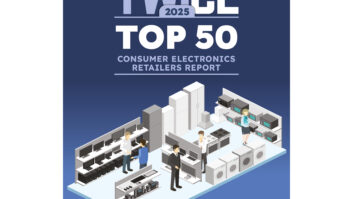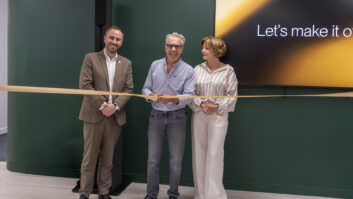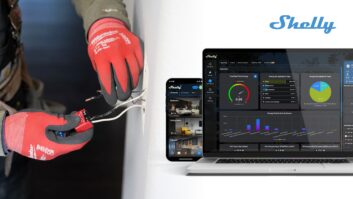TWICE: How can manufacturers support installation companies?
Goldstein: The CIS [Consumer Integrated Systems] group within Sony is almost like a company within a company. For small installers, we have simplified getting information and dealing with Sony. We have engineering on staff so that when somebody has a question on how to integrate a product, they have a place to call. We provide as much specific data about size and shape and connections to the product as we can. And we have a web site from which dealers can download pictures and architectural drawings of products. And we provide them with training, when needed.
My group also acts as an antenna for product feedback.
Bodley: An important link between manufacturers and installers is the manufacturer’s rep. The rep is an instrumental person in making sure that your product has the proper sell-through and information going with it.
The best reps have created their own information bridge – making and facilitating information. Sony doesn’t use reps; it created its own infrastructure. And when Jeff came to Sony, because he was an installer, there has been mammoth improvement that has increased our business.
But rep firms have relationships with the dealer. Many manufacturers have only casual relationships with dealers, sometimes friendships, but not a true business relationship. So reps should have full training, especially with the product, because it is really hard for a manufacturer to support a zillion small dealers. Mandating that reps have training, a classroom and people who are facilitators is essential.
Ekblad: There are four ways a manufacturer can help us. One is working with retailers to develop products that are easy to use, easy to interface, easy to assimilate into a system.
Another element is providing us with thorough information, even on the downside of their product, so that when we make a promise to a customer, we can underpromise and overdeliver.
The third is merchandising. Give us aid in making the product easily understandable for a customer and make it simple to communicate the benefits.
The last way is helping us recognize where we failed. Help us get out of difficulties. Help us service the product.
Harary: Custom installers don’t want to inventory too much product, and what would be optimum for an installer is to go online with a vendor to make sure inventory is available when needed.
Our extranet provides the ability for retailers to be able to, literally, go into our inventory system to find out what’s available for purchase, place the PO [purchase order], and have it shipped.
Sterns: We have a toll-free 800 number for technical support with five guys on the phone all day long to answer questions about hooking things up and integrating systems. We also do extensive road shows and training at CEDIA covering our own products but also other how-to topics.
We try to do all that stuff that makes us more than just a seller of goods.
Sheldon: We train on our own at the main CEDIA event and its regional events. We are also very active in writing very complete application guides that help them understand the application of our various products. But even with that in place, you still need to provide very competent technical support.
Sterns: We find that 48% of our business is red-, blue-, or orange-label shipping, and we have almost 800 SKUs, so we forecast those 800 SKUs on a monthly basis. We try to maintain 85% accuracy by month and by SKU so we can make sure we have the stuff on a shelf when it gets ordered by an installer.
We put an incredible amount of resources into resource planning, allocation, purchasing scheduling, and forecasting to ensure that we can support all of those SKUs, knowing our dealers want them the day they order, and we ship the same day we get the order. There is a lot of money being invested on the manufacturing side to support just-in-time inventory.
Goldstein: A key challenge for manufacturers is that the AV design and contracting community is not able to forecast what their needs will be in the next six months. They have no way to tell us.
TWICE: But in the custom channel, installers sign contracts for jobs that take six months or more to complete. Don’t they have a pretty good feel for what they’ll need a few months out?
Goldstein: Yes and no. Yes, they should. But the question is are they paying attention to what is actually in the works? Second, there is often the opportunity for AV designers to take a retrofit job or something that needs to be done in a very short period of time.
That is where, I think, the frustration level appears on the manufacturer and retailing side. A guy walks in, or you give him the presentation, and he says I want this done in two or three weeks. The temptation is to say yes you can when you know you can’t.
Sheldon: It would seem to be very easy to plan your jobs far enough out that you can easily administer the flow of inventory, but a custom job can require literally hundreds of components, and even the best-run business can reach the point where an entire job – several rooms of audio – can hinge on one small widget being in stock.
What encourages me is that software packages are coming out that are part of the initial presentation, or bid, and as you design every room, you allocate the products into this program, which creates purchase orders. It is helping dealers see what they need in inventory to complete an installation.
To give dealers the products they need when the need it, we forecast five months in advance to the actual amount that we think we need. On top of that, we forecast safety inventories, so if we have a really nice cushion to avoid going into a back-order situation. We update those forecasts monthly.
An awful lot of our business also goes out on a next-day basis, and a lot of our rep organizations also maintain inventories and distribute products within their market, so installers have a source very to them to get product on a next-day basis.
Sterns: We forecast our inventories on a 12-month rolling basis. We have two all-day meetings, one for the forecast, and one for sales and operations. We have various levels of safety stock, depending on whether they are A class, B class, or C class, and then, we ask our dealers every year to provide a forecast to us of how much they are going to sell on every particular product category.
We also try to maintain a wholesale distribution supply in every territory – a distributor, preferably a rep – to have local inventories in case of emergencies.
TWICE: Is there continuing movement by suppliers to use stocking reps?
Sterns: In our business, you have to use them because of so many small items, small dealers and short lead times. Dealers want to go somewhere on their way to a job site and pick up some widgets.
Sheldon: Frank and I attended a panel discussion, and the question was whether products should be put into distribution and whether rep-distributors are a problem-solving tool for industry. And there was a division.
Installers with a strong retail presence felt the stocking rep was threatening their position in the market. But people that were on the custom side wanted a local resource to rely on a daily basis. The retailers were concerned about a rep having product in stock that would go to someone who could compete with them.
Harary: Infinity used to have seven distributors, and over the course of the past six months, we have gone almost exclusively to rep-distributors. The fact of the matter is our sales reps in each market are our marketing arms in those marketplaces.
Bodley: There are so many custom installation companies that don’t have a favorite brand. They have them all. Yet, it’s essential that anybody in retail or custom tries to do as much business with as few vendors as possible, and I think that needs to be a cooperative effort.
Manufacturers of anything electronic need to see sales grow, and there is pressure to produce numbers and therefore pressure to put more people on. But the manufacturer could accomplish the same thing, with greater efficiency, by working more closely with existing dealers to help them grow. I’d rather sell more to one customer than have to go out and find three more. Not enough manufacturers really view it that way.
On the other hand, dealers also need to make commitments. There are times when a manufacturer is making the hottest product in the world, and there are times when that manufacturer slips with a product line that doesn’t quite make the mark and has reliability problems. Too often, the dealer drops the line, but if I want to be in business 10 or 20 years from now, I can’t do that if I have no special relationships with anyone. And that has to go both ways.
The fear the dealers have that a rep, or any type of distributor, will distribute products to any dealer is well founded. If anybody with a pulse can come in and write a PO at the order desk of that distributor, it will erode profits and value.
I know there are laws that prohibit certain amounts of controls, but there needs to be some understanding as to how the distribution will be controlled.
Sterns: There are lots of laws regarding things you can and can’t do, but there are still ways to influence distribution. We influence with our pricing structure, the fact that distributors have authorized territories whereas many other distributors are national. The fact that the types of distributors we use are custom hifi distributors as opposed to national security distributors.
We also have authorized distribution policies by product type so that something like a wall plate can be fairly widely distributed while a multi-channel amplifier, which requires more knowledge, is more limited in distribution.
Ekblad: Some retailers not only want to be committed to a product line but want to be the very best with that product and to take it to a new level, at every opportunity, with the vendor. I think that in developing strong relationships like that, exclusivity isn’t as much of an issue, although it is an important issue. Even widely distributed products can be integrated into the custom-installation situation.
Rich: From the support angle, the whole industry has improved 100 times in the past five years. But the dealer/installer also has to realize that it’s not just the manufacturer’s problem if there’s a bug. My advice to installers is that if there is a problem on-site, don’t ever call up the manufacturer and say it’s your fault or say to the client that it’s somebody else’s fault. It’s a team effort to figure out what the problem is. From my existing suppliers, I get all the support I need. But because I wasn’t able do this with the systems-integration side of my business, I had to become a manufacturer in the integration portion of my business.
Manufacturers are really starting to listen a lot more than they ever have to us, who are the ones talking to the homeowners and find out exactly what they want.












